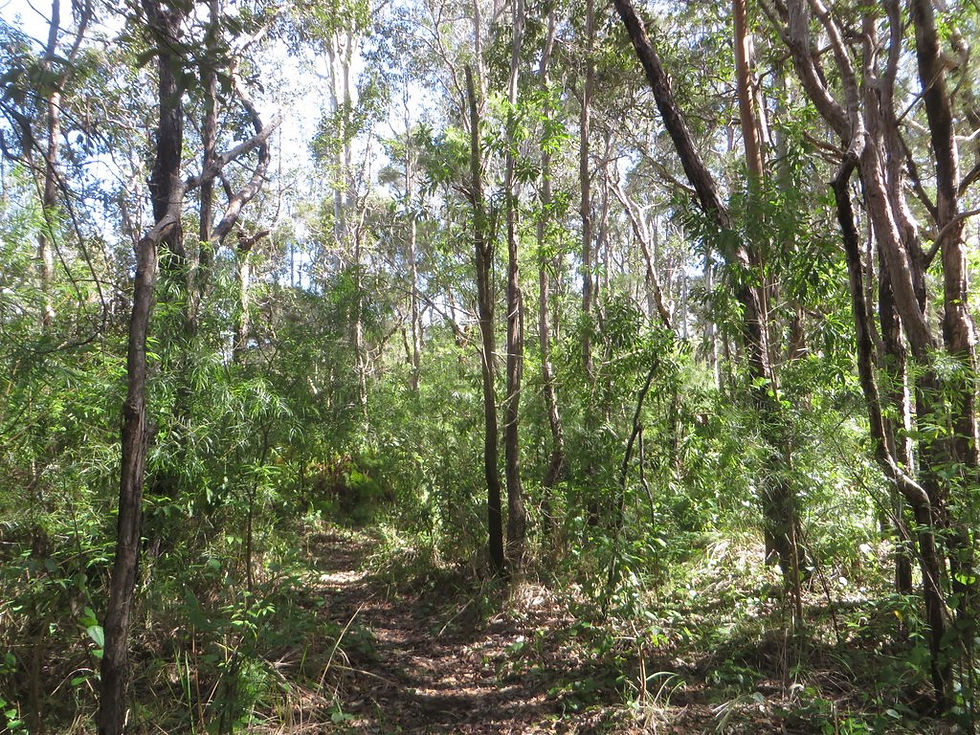The young forest
- Ian
- Dec 1, 2017
- 3 min read
Updated: Feb 14, 2022
The young forest is cool. The swamp turpentine and the flooded gums fight for the light forming a protective canopy. The forest ferns love the shade too, flourishing this close to the creek. The path winds through the trees following the creek.


After the 2012 fire the whole area has regrown. You can see here the aftermath of the fire in the same forest.
The white-necked heron, here with wings outstretched, arrived after some much needed rain put water in the wetland a day after the fire.
The forest ferns recover quickly if there is rain. The poison peach is fast growing and copes well in the dappled light, quickly filling the intermediate heights under the larger trees.


The poison peach dropped a lot of their leaves over the winter, not because they are deciduous, just a lack of rain. Many of the trees lost leaves over this winter. The heat broke records for winter and it didn't rain here for over 3 months.
I love this walk. The coolness of the forest always feels so good coming out of the heat. This growth is the result of 30 years without clearing or stock. I know I won't see the forest when it reaches its maturity. Maybe some other human will appreciate it but most importantly the wildlife will flourish in a diverse environment.
The vines scramble over the ground and run up the bushes. The tape vine has lovely heart shaped leaves. It can die off in the winter but quickly comes back when the weather warms.
The barbed wire vine has small thorns along the vine and is strong, growing in clumps it is difficult to get through. The vine is common in subtropical rainforests.
Down by the creek the forest ferns look lush and cool. The stream is flowing well now, winding its way through the sandy base.
Years ago the stream was a broad open sandy creek base with little vegetation on its banks. Gradually the vegetation has returned without constant grazing from cattle and horses. The tee tree swamp sedge formed blocks on the sandy banks, resisting the regular floods and so forming banks within the original banks. The stream gradually cutting down into the sandy floor, exposing logs which had long ago disappeared into the sand that filled the creek.

We have planted some local natives to add some of the original species that we can't find here. The bangalow palms are thriving along the water courses. The red cedars are surprisingly fast growers, already reaching 4m after only a few years. The red cedars were the driving force in the exploration and settlement of this region. There are few left now.

The forest casuarinas grow to a good size here where there is soil, deposited by the frequent flooding, and access to good water. The glossy black cockatoos love the seeds, choosing their favourite trees to sit and munch away.
Although winter had some very hot days, unusually hot, it was the lack of rain that dominated months. Stunning days, clear and sunny with cold nights but no rain. It is not our rainy season but three months without rain was something different. The grass turned crunchy. The trees started to lose lots of leaves. Our pond was drying up.
The rain did come in October. Enough to get the springs running and put some water in the wetland but not enough to fill everything. The trees responded almost immediately, growing new leaves and bursting into life again.

The days are heating up the snakes and goannas are regular visitors now. Our house python can't squeeze through the gaps in the ceiling any more so has taken up residence near the warmth of the roof along the verandah during the day. The swamp hens let us know each day it is curled up there by making a particular sound. We frequently hear from them and invariably find a snake or goanna. They will often herd the reptile away, pecking at their tail, to move it along.
The yellow-tailed black cockatoo have been feeding on the banksias around the house. We have seen several large flocks of them recently. We have a new gallery of them - click here.























Comments